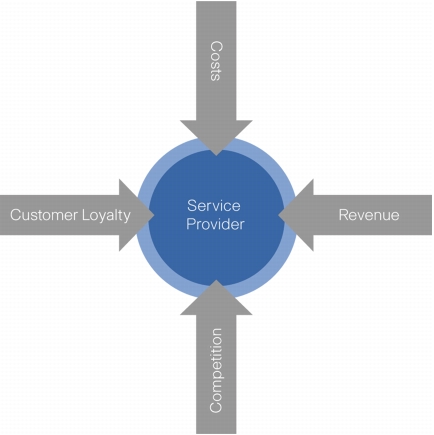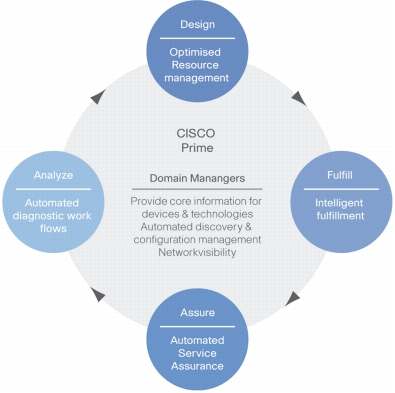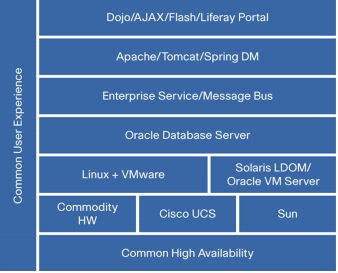What You Will Learn
• Reduce capital and operational costs
• Enhance operational efficiency
• Grow revenues
• Realize more value from technology investments
Introduction
Figure 1. Service Provider Challenges

Cisco Prime Architecture
Figure 2. Example of Cisco Prime Experience Lifecycle Management for IP Services

• Accelerate time-to-revenue. The Cisco Prime architecture can shave weeks off of deployment times through concepts such as pre-integration, automated service deployment, and converged management views of the entire service provider network. The architecture also provides "day zero" support for Cisco hardware and architectural solution blueprints, and integrated delivery with common components and standards-based open interfaces. Ultimately, it allows service providers to design and deliver new customer experiences more quickly, and with less risk.
• Improve operational efficiency. As service providers adopt new technologies to roll out differentiated services, they become more reliant on highly skilled, dedicated resources for fulfillment, maintenance, and quality. Maintaining these disparate management approaches is extremely costly, and makes service offerings inherently difficult to scale. Alternatively, the Cisco Prime architecture delivers visibility of the entire network - as well as workflows for fulfillment, assurance, and diagnostics. Cisco Prime can extend this comprehensive visibility across segmented functional groups. Or, for groups that maintain a functional demarcation (e.g., between fulfillment and assurance operations), the architecture easily allows for the appropriate enforcement of safeguards through role-based access control. In either case, the Cisco Prime architecture enables a shared, holistic understanding of the network. With the ability to visualize all inventory and services on the network and the topographical relationships between them through a single interface, service providers can deliver higher-quality services with fewer errors, at a lower cost.
• Dramatically lower total cost of ownership. The Cisco Prime Architecture is designed to help service providers reduce the costs of delivering quality customer experiences. It provides:
– Reduced training costs for end users through a common user experience, and reduced administrative costs through a common set of management tools.
– Service automation, allowing lower-level support personnel to perform "zero touch" provisioning, modifying, and repair functions
– Embedded Oracle database option for all components, allowing users to manage the database through the related component, without requiring advanced database administration training. Embedded databases include self-maintenance and routine management scripts out-of-the-box, and are ultimately manageable through the Cisco Prime interface
– Common technology stack for all components based on widely used and open-source components and software, as well as Cisco reusable technologies. (Figure 3.)
– Support for both Cisco Unified Computing System (UCS) and off-the-shelf commodity hardware
Figure 3. The Cisco Prime Architecture Common Technology Stack

• Easily support multi-vendor environments. To support heterogeneous network devices, as well as the variety of operations (OSS) and billing systems (BSS) service providers use, multi-vendor support is a key requirement of any management solution. The Cisco Prime architecture uses a common data model, based on open industry standards, and exposes a common set of northbound APIs across the entire suite to simplify integration with OSS/BSS systems. Cisco Prime applications support Cisco hardware "out-of-the-box," helping service providers achieve rapid-time-to-value. Cisco Prime applications also support non-Cisco devices, eliminating the need for separate element managers for each type of device.
• Maintain optimal hardware flexibility. Cisco Prime components are flexible enough to take advantage of either off-the-shelf commodity hardware or high-performance systems specialized for the most stringent service provider environments. For more demanding environments, service providers can use a fully integrated, benchmark-setting solution running on the Cisco Unified Computing System (UCS), run Cisco Prime suites fully virtualized, or run a dedicated Cisco Prime suite pre-installed on Cisco UCS as a hardware appliance.
• Adopt an overall management solution in a phased, incremental manner. While the Cisco Prime architecture allows service providers to address all domains within a single framework, it does not require them to do so. Service providers can adopt Cisco Prime solutions economically in phases, running standalone domain managers (such as Cisco Prime Network for the IP network or Cisco Prime Optical for the optical domain), and implement a converged solution in the future. Service providers that are cost conscious can start with the most critical tasks such as turn-up and network fulfillment. Over time, as their business grows and demand for automation increases, Cisco Prime components can be installed to support more of the complete experience lifecycle. Organizations can also migrate their existing management products to the equivalent Cisco Prime component. In this manner, organizations can better control deployment risk, budget, and timelines.
Accelerating Return-on-Investment
• Automatic discovery, allowing network engineers to easily find and map both IP/packet and optical network devices from Cisco and other infrastructure providers, from the access layer through aggregation to the core network
• Intelligent fulfillment, with automated, A-Z provisioning of services such as Carrier Ethernet services, L2/L3 VPNs, MPLS-TP tunnels, and L1 circuits based on real-time inventory and resource information direct from topological maps
• Comprehensive configuration management to automate the validation of changes to network elements and restore configurations to the desired state
• Automated service assurance powered by diagnostic workflows to help operators rapidly detect and isolate network faults
• Network visibility, providing the user with complete visibility across IP and optical domains, and over legacy TDM network infrastructure and new dense wavelength division multiplexing (DWDM) devices and circuits
Optimizing Revenue
Building Blocks of the Cisco Prime Architecture
Figure 4. Cisco Prime Architecture Overview

• Cisco Prime Data Model. At the core of the architecture, Cisco Prime provides a common data model across the end-to-end infrastructure under management and the entire experience lifecycle, from service design through provisioning and all aspects of management and optimization. By providing a common set of APIs for every element of the solution - instead of requiring service providers to integrate each element with support, billing, and other existing systems separately - Cisco Prime dramatically simplifies integrations. The Cisco Prime data model is based on the Multi-Technology Operations Systems Interface (MTOSI) 2.0 industry standard from the TeleManagement Forum (TMF) and is populated from Cisco Element (Domain) Managers.
• Cisco Prime Service Bus. The service bus coordinates activity among Lifecycle Managers (i.e., among elements controlling design, fulfillment, assurance, and analysis), and between lifecycle and domain managers. It provides a redundant, highly scalable framework with the ability to mediate messages, and embedded Prime Framework Services such as the scheduler, locator service, persistence, etc.
• Cisco Prime Abstraction Layer. This component removes the complexity of managing a wide variety of interfaces by abstracting the information into the Cisco Prime Data Model. The abstraction layer mediates information stored in the Cisco Prime Data Model and makes it available to all Cisco Prime Suite components and interfaces, and is also based on MTOSI 2.0 compliant messages.
• Cisco Domain Managers. Domain managers (or element managers) provide basic fault, configuration, accounting, performance, security (FCAPS) functionality for each specific technology domain. Examples include the Prime Network domain manager for IP/packet services and Prime Optical for optical transport.
• Cisco Prime Southbound Mediation Interfaces (SBI). The Cisco Prime SBI layer provides a common, mediated interface to communicate with any Cisco device. Each domain manager uses this element to abstract the intricacies of device communication via different protocols (i.e., SNMP, CLI, XML, CORBA, etc.) using standard interfaces. The SBI also includes a workflow engine that can be customized with graphical, drag-and-drop design tools. These tools simplify domain management in the field and help service providers customize and extend the network model without having to wait for new Cisco Prime software releases. Additionally, since the SBI is developed in close collaboration with the Cisco hardware business unit, it is designed from the ground up to optimize the interaction between Cisco devices and Cisco Prime.
• Cisco Prime Northbound Interfaces (NBI). These interfaces allow for direct access to lifecycle and domain managers by both Cisco Prime Central and third-party products such as OSS systems. They are standards-based and available in a number of formats, web services, and native XML, and can be further customized in the field. The NBI is also designed for maximum security, employing transport encryption and requiring authenticated access.
• Cisco Prime Software Development Kits (SDK). These SDKs provide service providers with maximum flexibility to customize the solution and easily integrate it into their environment. They include APIs and documentation for access to domain managers along with lifecycle managers for both northbound and southbound interfaces.
• Cisco Prime Central. Cisco Prime Central serves as both an operator and a management portal. It is the component of the Cisco Prime architecture that provides users with a single view of all inventory managed by the various domain managers, simplifying the management and provisioning of services across the end-to-end network infrastructure. It provides a common user experience with integrated operator workflows for each element of the experience lifecycle, single authenticated sign-on (SSO), and user management services with Role-Based Access Control (RBAC). It also provides an optional administrative interface for all products included in the suite that addresses common management tasks.
• Cisco Prime Lifecycle Managers (Design, Fulfill, Assure, Analyze). These applications provide end-to-end experience lifecycle management services across all technology domains. The lifecycle managers coordinate with each other through the Cisco Prime Service Bus, and rely on the common Cisco Prime Data Model for shared device and service context. Examples include Prime Fulfillment and Prime Performance Manager.
Conclusion